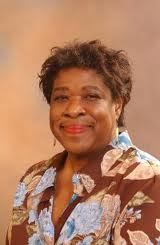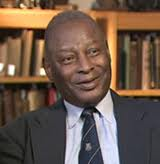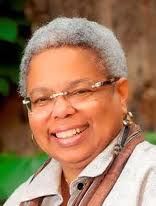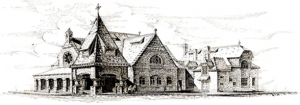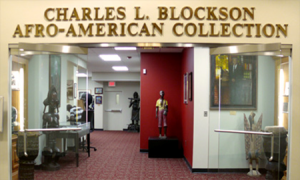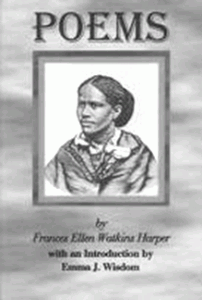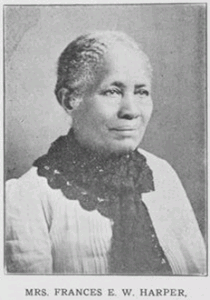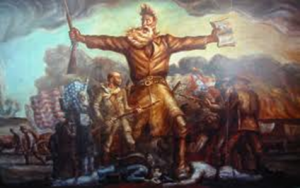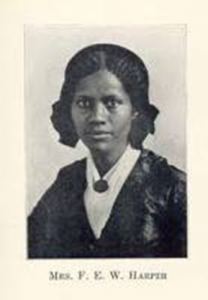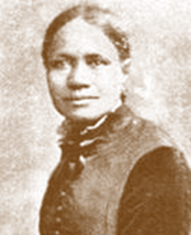The Poetry and Poetic Legacy of Frances E.W. Harper
Thursday, February 10th, 2011
Feb 24 7:00 pm Thursday, February 24, 7pm – Frances Harper Week
The Poetry and Poetic Legacy of Frances E.W. Harper
This event will feature Melba Joyce Boyd and Sonia Sanchez reading poetry by Frances E.W. Harper and their own poetry. An open reading of contemporary poetry in Harper’s tradition of social activism will follow. This event will include poetry by Philadelphia high school students who have been studying Frances E.W. Harper.
Sonia Sanchez is a poet, mother, activist, professor, and international lecturer on black culture and literature, women’s liberation, peace and racial justice. She has written over 16 books, including most recently, Morning Haiku. Sanchez was the first Presidential Fellow at Temple University, where she held the Laura Carnell Chair in English. The recipient of numerous awards, Sanchez has been honored by: the National Endowment for the Arts; the Pennsylvania Coalition of 100 Black Women; the National Black Caucus of State Legislators; the Governor’s Award for Excellence in the Humanities; the Peace and Freedom Award; and a Pew Fellowship in the Arts.
Melba Joyce Boyd is Distinguished Professor and Chair of Africana Studies at Wayne State University. She is the author of thirteen books, including Wrestling with the Muse: Dudley Randall and the Broadside Press which received the 2005 Black Caucus of the American Library Association Book Honor for Nonfiction, and the editor of Roses and Revolutions: the Collected Writings of Dudley Randall, which received the 2010 Library of Michigan Notable Books Award and was a finalist for a 2010 NAACP Image Award in Literature.
Falaka Fattah and the Political Legacy of Frances E.W. Harper
Thursday, February 10th, 2011
Feb 22 7:00 pm Tuesday, February 22, 7pm – Frances Harper Week
Falaka Fattah and the Political Legacy of Frances E.W. Harper
Falaka Fattah is the founder of House of Umoja, a Philadelphia activist, and mother of Congressman Chaka Fattah. Falaka Fattah’s great grandmother married the brother of Frances Ellen Watkins Harper’s husband. Every generation of the Fattah family has named one of their children after Frances Harper since then. They have treasured the family connection to Frances Harper and have been inspired and motivated in their community service by this nineteenth century artist and political activist. Moonstone is honored to present a program on this subject featuring a showing of A Place To Go Home To, a film by Kimmika Williams-Witherspoon on House of Umoja, and speakers honoring Falaka Fattah and the traditions inspired by Frances Ellen Watkins Harper.
For more information on Frances Harper Week go to: www.moonstoneartscenter.org/francesharper
Cover Page
Wednesday, January 26th, 2011
A Brighter Coming Day:
Rediscovering Frances Ellen Watkins Harper
(September 28, 1825 – February 22, 1911)
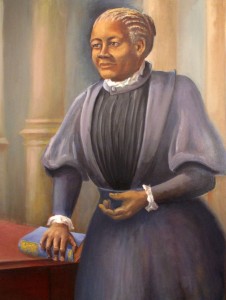
Portrait of Frances E.W. Harper by Leroy Forney commissioned by First Unitarian Chuch of Philadelphia
February 20 to February 27, 2011
100th Anniversary of the Death of Frances E.W. Harper
12 Events in Various Locations
Introduction and Biography
Tuesday, January 25th, 2011
Why I Love Frances Harper
“I am attracted to smart women. I am attracted to talented women. I am attracted to brave women. I married one and we live happily ever after. Then, six months ago, I was introduced to this amazing woman who lived just a few blocks from me. Her name is Frances Ellen Watkins Harper. Ok, so she died a hundred years ago, but that is not relevant. It is so much fun to fall in love.
I love language. I love learning new things. I love history. Especially the history of the ongoing struggle to make this world, this country, this city the kind of place it should be: where we are free; where opportunity is not based on race, class or gender; where we take care of each other. And I love sharing. Now that I know Frances, I want everyone to know her.” – Larry RobinFRANCES E. W. HARPER

Frances Ellen Watkins Harper’s story is one of bravery, creative excellence, political consciousness, activism, and determination during the period preceding, during, and after the Civil War.
- 1825 – Born Frances Ellen Watkins in Baltimore, Maryland, she was orphaned at the age of three and raised by her uncle, the abolitionist William Watkins.
- 1846 – She began her amazing career as a writer by publishing her first book of poetry, Forest Leaves, at the age of 21.
- 1853 – Frances Watkins first moved to Philadelphia after meeting William Still, in order to become active in the Underground Railroad.
- 1858 – She refused to give up her seat or ride in the “colored” section of a segregated trolley car in Philadelphia (100 years before Rosa Parks) and wrote one her most famous poems, “Bury Me In A Free Land,” when she got very sick while on a lecturing tour. Her short story “The Two Offers” became the first short story to be published by an African American.
- 1859 – A dedicated abolitionist, Harper was one of the few public figures who did not abandon John Brown after his failed effort at Harpers Ferry, instead writing to him and staying with his wife, Mary, at the home of Lucretia Mott (Philadelphia’s leading Quaker Abolitionist) for the two weeks preceding his hanging.
- 1860 – She married Fenton Harper, had a daughter, Mary, and was widowed in 1864.
- 1865 – In the immediate post-Civil War years, Harper returned to the lecture circuit, focusing her attentions on education for the formerly enslaved, on the Equal Rights Movement and on the Temperance Movement.
- 1868 – She spent four years speaking and teaching in churches and Freedmen’s schools in the South, stressing the importance of education and self-empowerment.
- 1892 – Harper published her most famous novel, Iola Leroy, at the age of 67. This novel, which was written in Philadelphia, was a best seller and is one of the few books from this period to look at the mid-nineteenth century American landscape through African-American eyes.
- 1896 – Frances Harper became Vice President of the newly formed National Association of Colored Women.
- 1911 – Frances Ellen Watkins Harper died on February 22, 1911.
Frances E.W. Harper is considered the “Mother of African American Journalism” as well as the most famous nineteenth century African American poet and novelist. In her role as a political activist, Frances Ellen Watkins Harper was a brave, principled, and talented advocate for freedom and equality for everyone, speaking for the Anti-Slavery societies before the Civil War and for Women’s Suffrage and Temperance movements after. The study of her life not only gives us a picture of the lived experiences of an intelligent, educated, African American woman in the nineteenth century, but also provides us with a snapshot of Philadelphia and the nation from a perspective that is not usually presented.
Despite all of her remarkable accomplishments, Frances E.W. Harper’s name cannot be found in most history books.
Program of Events
Saturday, January 15th, 2011A BRIGHTER COMING DAY SPEAKERS
Lena Ampadu is Professor in the Department of English, Towson University, where she teaches composition, Survey of African American Literature, Major Writers of African American Literature, and courses on black women writers. In addition, she is the immediate past Director of the African and African American Studies Program. She has published a number of essays on composition and rhetoric, as well as on African American literature. Her specialty is oral traditions in African and African American women’s novels. Her publications include “The Poetry of Paul Laurence Dunbar and the Influence of African Aesthetics” (We Wear he Mask: Paul Laurence Dunbar and the Politics of Representative Reality) and “Maria Stewart: Womanism, Black Nationalism, and the Rhetoric of Black Preaching” (Black Women’s Intellectual Tradition: Speaking Their Minds). She has lectured on the Poetic Voice of Frances E.W. Harper and the Prose, Poetics, and Politics of Frances E. W. Harper and is presently working on a manuscript on Frances Harper and Pauline Hopkins.
“Harper was a fascinating woman, an outspoken feminist of her day whose poetry and prose often delved into the challenges and problems facing all women, while celebrating women’s ability to survive and overcome. A social visionary, Harper commented on the sexual double standard that existed during the nineteenth century men and women; advocating literacy as an empowering, liberating tool for women; and used her pen and voice in the public sphere to oppose slavery. Many of her beliefs on justice and equality still resonate with meaning for today’s society.” -Lena Ampadu Charles L. Blockson is founder and curator of the Charles L. Blockson Afro-American Collection at Temple University which includes rare texts, slave narratives, art, and a host of other artifacts significant in African-American history. Born in Norristown, Pennsylvania, Blockson graduated from Pennsylvania State University and holds an honorary doctorate from Villanova University. Blockson has written several essays and books centered on African-American history, especially in Pennsylvania, including The Underground Railroad and Liberty Bell Era: The African-American Story.
“She was an extraordinary woman of commitment and conviction for her people. She was a poet with a gift for words and an activist for African American, civil rights and Women’s rights. Oftentimes, she was overshadowed by her contemporaries, Harriet Tubman and Sojourner Truth, but she is a significant person whose legacy is long overdue.” – Charles L. Blockson
Melba Joyce Boyd is Distinguished Professor and Chair of Africana Studies at Wayne State University. She is the author of thirteen books, including Wrestling with the Muse: Dudley Randall and the Broadside Press which received the 2005 Black Caucus of the American Library Association Book Honor for Nonfiction, and the editor of Roses and Revolutions: the Collected Writings of Dudley Randall, which received the 2010 Library of Michigan Notable Books Award and was a finalist for a 2010 NAACP Image Award in Literature. Her 1994 book, Discarded Legacy: Politics and Poetics in the Life of Frances E. W. Harper, 1825-1911, was widely reviewed and praised by critics. Eight of her books are collections of poetry, the most recent of which is Death Dance of a Butterfly. She has won a number of awards including a Michigan Council for the Arts Individual Artist Award, and in 2009 she was a Nominee for the Kresge Eminent Artist Award. She is the series coeditor of the African American Life Series at WSU Press, and a contributing editor for The Black Scholar: The Journal of Black Studies and Research.
“Harper’s insight, developed during an era rife with violent enforcement of racism, sexism, and classism, constitutes a viable ideological framework for contemporary radical thought.” – Melba Joyce Boyd Frances Smith Foster is Charles Howard Candler Professor of English and Women’s Studies at Emory University. She regularly teaches undergraduate and graduate courses in African American literature and culture and in women’s literature and culture. Recent course offerings have included “The Profession of English,” “Family, Marriage and (Sexual) Morality in 19th century America,” “Slavery and the African American Literary Imagination, “Becoming a Woman,” and “African American Prize-winning and Prize-worthy Literature.” She has edited or written more than a dozen books, including Love and Marriage in Early African America, Written By Herself: Literary Production by African American Women, 1746-1892 and Witnessing Slavery: The Development of the Ante-Bellum Slave Narrative. She has edited, alone or jointly, works that include The Oxford Companion to African American Literature and The Norton Anthology of African American Literature as well as editions of several African American women’s texts including Minnie’s Sacrifice, Sowing and Reaping, and Trial and Triumph: Three Rediscovered Novels by Frances E.W. Harper. She is the editor of A Brighter Coming Day: A Frances Ellen Watkins Harper Reader.
“One of the most interesting things about Frances E.W. Harper is her continued optimism in light of the less than inspiring realities with which she lived. She vowed to sing songs for the people and those songs were less light-hearted than light-giving.” – Frances Smith Foster Sonia Sanchez is a poet, mother, activist, professor, and international lecturer on black culture and literature, women’s liberation, peace and racial justice. She has written over 16 books, including most recently, Morning Haiku. Sanchez was the first Presidential Fellow at Temple University, where she held the Laura Carnell Chair in English. The recipient of numerous awards, Sanchez has been honored by: the National Endowment for the Arts; the Pennsylvania Coalition of 100 Black Women; the National Black Caucus of State Legislators; the Governor’s Award for Excellence in the Humanities; the Peace and Freedom Award; and a Pew Fellowship in the Arts. Sanchez’s exemplary writing skills have earned her the American Book Award and the Langston Hughes Poetry Award. Her book, Does Your House Have Lions?, was a finalist for the National Book Critics Circle Award. Having lectured and read poetry to over 500 universities, colleges and organizations in the United States, Africa, Cuba, England, the Caribbean, Australia, Nicaragua, the People’s Republic of China, Norway and Canada, Sanchez has established a reputation as a highly renowned author and scholar.
“This abolitionist black woman writer weaves the literary and political in her poems, novels, newspaper columns and essays. In doing so her life and writings were one and the same.” – Sonia Sanchez A BRIGHTER COMING DAY PROGRAM
Commemoration of the Life
& Work of Frances Ellen Watkins Harper
Sunday, February 20, 2011 – 11am
-The First Unitarian Church of Philadelphia
2125 Chestnut Street, Philadelphia, PA 19103, 215-701-9072A commemoration of the Life & Work of Frances Ellen Watkins Harper, who died on February 22, 1911 and whose funeral was held at The First Unitarian Church of Philadelphia one hundred years ago today. It will feature the unveiling of a commissioned portrait of Frances E.W. Harper, presentation of the City Council Resolution to the Fattah family and other activities, including the reading of poetry by Frances E.W. Harper and music from the Universal Drum and Dance company.
Charles L. Blockson Lecture on Frances E. W. Harper
Tuesday, February 22, 2011 -2pm
- Charles L. Blockson Collection at Temple University
1330 W. Berks Street, Philadelphia PA 19122, 215-204-6632
A lecture by Charles L. Blockson on Frances E. W. Harper. Charles L. Blockson is founder and curator of the Charles L. Blockson Afro-American Collection at Temple University which incudes rare texts, slave narratives, art, and a host of other artifacts significant in African-American history. Blockson has written several essays and books centered on African-American history, especially in Pennsylvania, including The Underground Railroad and Liberty Bell Era: The African-American Story.
Falaka Fattah and The Political Legacy of Frances Ellen Watkins Harper
Tuesday, February 22, 2011 – 7pm
-The Moonstone Arts Center
110A S. 13th Street, Philadelphia PA 19107, 215-735-9600
Falaka Fattah is the founder of House of Umoja, a Philadelphia activist, and mother of Congressman Chaka Fattah. Falaka Fattah’s great grandmother married the brother of Frances Ellen Watkins Harper’s husband. Every generation of the Fattah family has named one of their children after Frances Harper since then. They have treasured the family connection to Frances Harper and have been inspired and motivated in their community service by this nineteenth century artist and political activist. Moonstone is honored to present a program on this subject featuring a showing of A Place To Go Home To, a film by Kimmika Williams-Witherspoon on House of Umoja, and speakers honoring Falaka Fattah and the traditions inspired by Frances Ellen Watkins Harper.
Chat in the Stacks with Lena Ampadu
Wednesday, February 23, 2011 –2:30pm
- Paley Library Lecture Hall, Temple University
1210 Polett Walk, Philadelphia, PA 19122-6088, 215-204-0744
Lena Ampadu, Professor of English and former Director of African and African American Studies Program at Towson University, leads a discussion on the Prose, Poetics and Politics of Frances E. W. Harper.
Discarded Legacy: Politics and Poetics in the Life of Frances Ellen Watkins Harper
Wednesday, February 23, 2011 – 6pm
- The Historical Society of Pennsylvania
1300 Locust Street, Philadelphia, PA 19107, 215-735-6200A Panel Discussion with: Lena Ampadu – Professor of English and former Director of African and African American Studies Program at Towson University. Ampadu’s specialty is oral traditions in African and African American women’s novels. She has lectured on the Poetic Voice of Frances E.W. Harper and the Prose, Poetics, and Politics of Frances E. W. Harper.
Melba Joyce Boyd – Distinguished Professor and Chair of Africana Studies at Wayne State University. She is the author of thirteen books, including Discarded Legacy: Politics and Poetics in the Life of Frances E. W. Harper, 1825-1911, the only book of criticism available on Frances E.W. Harper.
Sonia Sanchez – Author of more than a dozen books of poetry, including Shake Loose My Skin: New and Selected Poems. Sanchez was the first Presidential Fellow at Temple University, where she began teaching in 1977, and held the Laura Carnell Chair in English there until her retirement in 1999. She has taught and lectured around the world and embodies in her life and work the legacy of Frances E.W. Harper.
Discarded Legacy: Politics and Poetics in the Life of Frances Ellen Watkins Harper
Thursday, February 24, 2011 – 10am
- School District of Philadelphia Auditorium
440 N. Broad Street, Philadelphia PA19107, 215-400-5719
A presentation by Melba Joyce Boyd for teachers and students co-sponsored by the Social Studies Department of the School District of Philadelphia.
The Poetry and Poetic Legacy of Frances E.W. Harper
Thursday, February 24, 2011 –7pm
- The Moonstone Arts Center
110A S. 13th Street, Philadelphia PA, 19107 – 215-735-9600
This event will feature Melba Joyce Boyd and Sonia Sanchez reading poetry by Frances E.W. Harper and their own poetry. An open reading of contemporary poetry in Harper’s tradition of social activism will follow. This event will include poetry by Philadelphia high school students who have been studying Frances E.W. Harper.
A Brighter Coming Day: Rediscovering Frances E. W. Harper
Friday, February 25, 2011 – 7pm
- Ruth Auditorium, Nesbitt Hall, Drexel University
33rd and Market Streets, Philadelphia, PA
A lecture by Frances Smith Foster, Charles Howard Candler Professor of English and Women’s Studies at Emory University. Frances Smith Foster compiled and edited A Brighter Coming Day: A Frances Ellen Watkins Harper Reader, the only collection of Harper’s work available. Her research discovered three novels published as serials in the Christian Recorder, the journal of the AME church. Foster then published Minnie’s Sacrifice, Sowing and Reaping, and Trial and Triumph: Three Rediscovered Novels by Frances Ellen Watkins Harper.
A Brighter Coming Day: Rediscovering Frances E. W. Harper for Teachers
Saturday, February 26, 2011 – 9am
- National Constitution Center
Independence Mall, 525 Arch Street, Philadelphia, PA 19106, 215-409-6600
A Teacher Training with Frances Smith Foster on Frances E. W. Harper and her work. This program carries Act 48 credits for Philadelphia teachers and will include curriculum and other materials to help teachers present the Antebellum, Civil War and Reconstruction periods from an African-American viewpoint.
Trailblazers To Freedom
Saturday, February 26, 2011 –1pm
- African American Museum in Philadelphia
701 Arch Street, Philadelphia PA 19106, 215-574-0380
The African American Museum in Philadelphia’s Trailblazers to Freedom Traveling Trunk Program offers an exciting series of educational resources for classroom instruction. Trunks are complete with instructional information, replicated artifacts and primary source documents, along with related lesson plans and hands-on activities that are based on specific people and themes of the exhibition to help students better understand the history of Philadelphia’s African American community from 1776 to 1876. The Traveling Trunk explores the life and times of social activist Frances Ellen Watkins Harper, who expressed herself through the written and spoken word. The Trailblazers to Freedom Traveling Trunk is an innovative teaching tool that allows students to interact with notable history makers and events that helped shape visions and dreams of freedom and equality in colonial America. Philadelphia’s history is brought to life through artifacts, multi-media presentations and classroom activities.
Remembering Frances Ellen Watkins Harper
Sunday, February 27, 2011 –11am
- Mother Bethel AME Church
419 S. 6th Street, Philadelphia PA 19147, 215-925-0616
This event will feature a sermon by Reverend Mark Kelly Tyler and other activities. Frances E.W. Harper was raised by her uncle William Watkins as a member of the Sharp Street United Methodist Church (formerly Methodist Episcopal) in Baltimore and she taught Sunday School at Mother Bethel in Philadelphia.
Bury Me In A Free Land
Sunday, February 27, 2011 – 2pm
- Eden Cemetery
1434 Springfield Road, Collingdale, PA 19023, 610-563-8737
A graveside memorial to Frances E.W. Harper with music and poetry.
*Bus transportation between the events at Mother Bethel and the Eden Cemetery may be provided. If interested, please contact Larry Robin at: larry@moonstoneartscenter.org.
Many events in the program will include a short theatrical presentation by a Sakai, a professional actress, who will talk about Harper’s life and perform her poetry and prose. Frances Harper’s Poetry
Friday, January 14th, 2011The Slave Mother (1854)
Heard you that shriek? It rose
So wildly on the air,
It seemed as if a burden’d heart
Was breaking in despair.Saw you those hands so sadly clasped–
The bowed and feeble head–
The shuddering of that fragile form–
That look of grief and dread?Saw you the sad, imploring eye?
Its every glance was pain,
As if a storm of agony
Were sweeping through the brain.She is a mother pale with fear,
Her boy clings to her side,
And in her kirtle vainly tries
His trembling form to hide.He is not hers, although she bore
For him a mother’s pains;
He is not hers, although her blood
Is coursing through his veins!He is not hers, for cruel hands
May rudely tear apart
The only wreath of household love
That binds her breaking heart.His love has been a joyous light
That o’er her pathway smiled,
A fountain gushing ever new,
Amid life’s desert wild.His lightest word has been a tone
Of music round her heart,
Their lives a streamlet blent in one–
Oh, Father! must they part?They tear him from her circling arms,
Her last and fond embrace.
Oh! never more may her sad eyes
Gaze on his mournful face.No marvel, then, these bitter shrieks
Disturb the listening air:
She is a mother, and her heart
Is breaking in despair.
Bury Me in a Free Land (1858)
By Frances E.W. HarperMake me a grave where’er you will,
In a lowly plain, or a lofty hill;
Make it among earth’s humblest graves,
But not in a land where men are slaves.I could not rest if around my grave
I heard the steps of a trembling slave;
His shadow above my silent tomb
Would make it a place of fearful gloom.I could not rest if I heard the tread
Of a coffle gang to the shambles led,
And the mother’s shriek of wild despair
Rise like a curse on the trembling air.I could not sleep if I saw the lash
Drinking her blood at each fearful gash,
And I saw her babes torn from her breast,
Like trembling doves from their parent nest.I’d shudder and start if I heard the bay
Of bloodhounds seizing their human prey,
And I heard the captive plead in vain
As they bound afresh his galling chain.If I saw young girls from their mother’s arms
Bartered and sold for their youthful charms,
My eye would flash with a mournful flame,
My death-paled cheek grow red with shame.I would sleep, dear friends, where bloated might
Can rob no man of his dearest right;
My rest shall be calm in any grave
Where none can call his brother a slave.I ask no monument, proud and high,
To arrest the gaze of the passers-by;
All that my yearning spirit craves,
Is bury me not in a land of slaves.
Learning To Read (1872)
Very soon the Yankee teachers
Came down and set up school;
But, oh! how the Rebs did hate it, -
It was agin’ their rule.Our masters always tried to hide
Book learning from our eyes;
Knowledge did’nt agree with slavery -
‘Twould make us all too wise.But some of us would try to steal
A little from the book,
And put the words together,
And learn by hook or crook.I remember Uncle Caldwell,
Who took pot liquor fat
And greased the pages of his book,
And hid it in his hat.And had his master ever seen
The leaves upon his head,
He’d have thought them greasy papers,
But nothing to be read.And there was Mr. Turner’s Ben,
Who heard the children spell,
And picked the words right up by heart,
And learned to read ‘em well.Well, the Northern folks kept sending
The Yankee teachers down;
And they stood right up and helped us,
Though Rebs did sneer and frown.And I longed to read my Bible,
For precious words it said;
But when I begun to learn it,
Folks just shook their heads,And said there is no use trying,
Oh! Chloe, you’re too late;
But as I was rising sixty,
I had no time to wait.So I got a pair of glasses,
And straight to work I went,
And never stopped till I could read
The hymns and Testament.Then I got a little cabin
A place to call my own -
And I felt as independent
As the queen upon her throne.
Songs for the People (1894)
Let me make the songs for the people,
Songs for the old and young;
Songs to stir like a battle-cry
Wherever they are sung.Not for the clashing of sabres,
For carnage nor for strife;
But songs to thrill the hearts of men
With more abundant life.Let me make the songs for the weary,
Amid life’s fever and fret,
Till hearts shall relax their tension,
And careworn brows forget.Let me sing for little children,
Before their footsteps stray,
Sweet anthems of love and duty,
To float o’er life’s highway.I would sing for the poor and aged,
When shadows dim their sight;
Of the bright and restful mansions,
Where there shall be no night.Our world, so worn and weary,
Needs music, pure and strong,
To hush the jangle and discords
Of sorrow, pain, and wrong.Music to soothe all its sorrow,
Till war and crime shall cease;
And the hearts of men grown tender
Girdle the world with peace.
A Double Standard (1895)
Do you blame me that I loved him?
If when standing all alone
I cried for bread a careless world
Pressed to my lips a stone.Do you blame me that I loved him,
That my heart beat glad and free,
When he told me in the sweetest tones
He loved but only me?Can you blame me that I did not see
Beneath his burning kiss
The serpent’s wiles, nor even hear
The deadly adder hiss?Can you blame me that my heart grew cold
The tempted, tempter turned;
When he was feted and caressed
And I was coldly spurned?Would you blame him, when you draw from me
Your dainty robes aside,
If he with gilded baits should claim
Your fairest as his bride?Would you blame the world if it should press
On him a civic crown;
And see me struggling in the depth
Then harshly press me down?Crime has no sex and yet to-day
I wear the brand of shame;
Whilst he amid the gay and proud
Still bears an honored name.Can you blame me if I’ve learned to think
Your hate of vice a sham,
When you so coldly crushed me down
And then excused the man?Would you blame me if to-morrow
The coroner should say,
A wretched girl, outcast, forlorn,
Has thrown her life away?Yes, blame me for my downward course,
But oh! remember well,
Within your homes you press the hand
That led me down to hell.I’m glad God’s ways are not our ways
He does not see as man;
Within His love I know there’s room
For those whom others ban.I think before His great white throne,
His throne of spotless light,
That whited sepulchres shall wear
The hue of endless night.That I who fell, and he who sinned,
Shall reap as we have sown;
That each the burden of his loss
Must bear and bear alone.No golden weights can turn the scale
Of justice in His sight;
And what is wrong in woman’s life
In man’s cannot be right.Frances Harper’s Prose
Thursday, January 13th, 2011Letter From Frances Ellen Watkins to John Brown
on November 25, 1859Dear Friend: although the hands of Slavery throw a barrier between you and me, and it may not be my privilege to see you in your prison-house, Virginia has no bolts or bars through which I dread to send you my sympathy. In the name of the young girl sold from the warm clasp of a mother’s arms to the clutches of a libertine or a profligate, – in the name of the slave mother, her heart rocked to and fro by the agony of her mournful separations, – I thank you, that you have been brave enough to reach out your hands to the crushed and blighted of race. You have rocked the bloody Bastille; and I hope that from our sad fate great good may arise to the cause of freedom. Already from your prison has come a shout of triumph against the giant sin of our country. The hemlock is distilled with victory when it is pressed to the lips of Socrates. The Cross becomes a glorious ensign when Calvary’s page-browed sufferer yields up his life upon it. And, if Universal Freedom is ever to be the dominant power of the land, your bodies may be only her first stepping stones to dominion. I would prefer to see Slavery go down peaceably by men breaking off their sins by righteousness and their iniquities by showing justice and mercy to the poor; but we cannot tell what the future may bring forth. God writes national judgments upon national sins; and what may be slumbering in the storehouse of divine justice we do not know. We may earnestly hope that your fate will not be a vain lesson, that it will intensify our hatred of Slavery and love of freedom, and that your martyr grave will be a sacred altar upon which men will record their vows of undying hatred to that system which tramps on man and bids defiance to God. I have written to your dear wife, and sent her a few dollars, and I pledge myself to you that I will continue to assist her. May the ever-blessed god shield you and your fellow-prisoners in the darkest hour. Send my sympathy to your fellow-prisoners; tell them to be of good courage; to seek a refuge in the Eternal God, and lean upon His everlasting arms for a sure support. If any of them, like you, have a wife or children that I can help, let them send me word.
Excerpt from “We Are All Bound Up Together”
By Frances E.W. HarperIn May 1866, Frances Ellen Watkins Harper, a leading poet, lecturer and civil rights activist, addressed the Eleventh National Women’s Rights Convention in New York, joining Elizabeth Cady Stanton, Susan B. Anthony, and Lucretia Mott, who were among the featured speakers. Her address appears below.
I feel I am something of a novice upon this platform. Born of a race whose inheritance has been outrage and wrong, most of my life had been spent in battling against those wrongs. But I did not feel as keenly as others, that I had these rights, in common with other women, which are now demanded.[…]
We are all bound up together in one great bundle of humanity, and society cannot trample on the weakest and feeblest of its members without receiving the curse in its own soul. You tried that in the case of the negro. You pressed him down for two centuries; and in so doing you crippled the moral strength and paralyzed the spiritual energies of the white men of the country. When the hands of the black were fettered, white men were deprived of the liberty of speech and the freedom of the press. Society cannot afford to neglect the enlightenment of any class of its members. At the South, the legislation of the country was in behalf of the rich slaveholders, while the poor white man was neglected. What is the consequence today? From that very class of neglected poor white men, comes the man who stands today, with his hand upon the helm of the nation. He fails to catch the watchword of the hour, and throws himself, the incarnation of meanness, across the pathway of the nation. My objection to Andrew Johnson is not that he has been a poor white man; my objection is that he keeps “poor whits” all the way through. (Applause.) That is the trouble with him.
This grand and glorious revolution which has commenced, will fail to reach its climax of success, until throughout the length and breadth of the American Republic, the nation shall be so color-blind, as to know no man by the color of his skin or the curl of his hair. It will then have no privileged class, trampling upon outraging the unprivileged classes, but will be then one great privileged nation, whose privilege will be to produce the loftiest manhood and womanhood that humanity can attain.
I do not believe that giving the woman the ballot is immediately going to cure all the ills of life. I do not believe that white women are dew-drops just exhaled from the skies. I think that like men they may be divided into three classes, the good, the bad, and the indifferent. The good would vote according to their convictions and principles; the bad, as dictated by prejudice or malice; and the indifferent will vote on the strongest side of the question, with the winning party.You white women speak here of rights. I speak of wrongs. I, as a colored woman, have had in this country an education which has made me feel as if I were in the situation of Ishmael, my hand against every man, and every man’s hand against stop the car rather than let me ride.
In advocating the cause of the colored man, since the Dred Scott decision, I have sometimes said I thought the nation had touched bottom. But let me tell you there is a depth of infamy lower than that. It is when the nation, standing upon the threshold of a great peril, reached out its hands to a feebler race, and asked that race to help it, and when the peril was over, said, You are good enough for soldiers, but not good enough for citizens. When Judge Taney said that the men of my race had no rights which the white man was bound to respect, he had not seen the bones of the black man bleaching outside of Richmond. He had not seen the thinned ranks and the thickened graves of the Louisiana Second, a regiment which went into battle nine hundred strong, and came out with three hundred. He had not stood at Olustee and seen defeat and disaster crushing down the pride of our banner, until word was brought to Col. Hallowell, “The day is lost; go in and save it;” and black men stood in the gap, beat back the enemy, and saved your army.
Excerpt from “A Heritage of Scorn”
By Frances Ellen Watkins Harper
National Council of Women of the United States, Feb. 1891I deem it a privilege to present the negro, not as a mere dependent asking for Northern sympathy or Southern compassion, but as a member of the body politic who has a claim upon the nation for justice, simple justice, which is the right of every race, upon the government for protection, which is the rightful claim of every citizen, and upon our common Christianity for the best influences which can be exerted for peace on earth and good-will to man.
Our first claim upon the nation and government is the claim for protection to human life. That claim should lie at the basis of our civilization, not simply in theory but in fact. Outside of America, I know of no other civilized country, Catholic, Protestant, or even Mahometan, where men are still lynched, murdered, and even burned for real or supposed crimes. . . . A government which has power to tax a man in peace, and draft him in war, should have power to defend his life in the hour of peril. A government which can protect and defend its citizens from wrong and outrage and does not is vicious. A government which would do it and cannot is weak; and where human life is insecure through either weakness or viciousness in the administration of law, there must be a lack of justice, and where this is wanting nothing can make up the deficiency.
It is said the negro is ignorant. But why is he ignorant? It comes with ill grace from a man who has put out my eyes to make a parade of my blindness,—to reproach me for my poverty when he has wronged me of my money. If the negro is ignorant, he has lived under the shadow of an institution which, at least in part of the country, made it a crime to teach him to read the name of the ever-blessed Christ. If he is poor, what has become of the money he has been earning for the last two hundred and fifty years? Years ago it was said cotton fights and cotton conquers for American slavery. The negro helped build up that great cotton power in the South, and in the North his sigh was in the whir of its machinery, and his blood and tears upon the warp and woof of its manufactures.
But there are some rights more precious than the rights of property or the claims of superior intelligence: they are the rights of life and liberty, and to these the poorest and humblest man has just as much right as the richest and most influential man in the country.Frances Ellen Watkins Harper: A Literary Timeline
Thursday, January 13th, 2011This timeline chronicles not only personal events in the life of Frances Ellen Watkins Harper, but also literary milestones and historical landmarks that occurred during her lifetime. In it, Frances E. W. Harper will be referred to as Watkins until her marriage to Fenton Harper in 1860. The ages that follow each year refer to Harper’s age at the given time.
1825 – Frances E. Watkins, daughter of free black parents, born in Baltimore, Maryland on September 24, 1825
1828 – 3yr – Watkins is orphaned and relocates to live with Aunt and Uncle Watkins
1829 – 4yr – Frances Wright begins publication of The Free Enquirer
1833 – 8yr – Lydia Maria Child, Appeal in Favor of That Class of Americans Called Africans
1834 – 9yr – American Female Moral Reform Society (AFMR) formed
1835 -10yr – Lydia Maria Child, A History of the Condition of Women
1836 – 11yr – Catharine Ester Beecher, Letters on the Difficulties of Religion
1837 – 12yr – Ralph Waldo Emerson, “An Oration”
1838 – 13yr – Underground Railroad organized
1839 – 14yr – The mill girls of Lowell, Massachusetts, begin publishing The Lowell Offering, a monthly magazine of poetry, fiction and essays
1846 – 21yr – Watkins, Forest Leaves
1847 – 22yr – Charlotte Bronte, Jane Eyre and Emily Bronte, Wuthering Heights
1849 – 24yr -Harriet Tubman escapes to the North and begins working with the Underground Railroad. Tubman helps at least 300 slaves to escape before the Civil War; during the war, she worka as a nurse, cook, laundress, and, it is said, as a spy behind Confederate lines for the Union forces. Hawthorne publishes The Scarlet Letter.
1850 – 25yr – Watkins taught sewing as the first female teacher at Union Seminary in Columbus, Ohio
1851 -26yr – Watkins works as a teacher in Little York, Pennsylvania. Melville pens Moby Dick;
Harriet Beecher Stowe, Uncle Tom’s Cabin.1852 -27yr – Watkins, The Two Offers
Frederick Douglass, “The Heroic Slave”1853 -28yr – Watkins moves to Philadelphia. Her poem, “Eliza Harris,” is published in Frederick Douglass’ Paper on December 23, 1853. Her poems “Saved by Faith,” “The Contrast,” and “The Drunkard’s Child” are employed by the Maine Anti-Slavery Society to carry the abolitionist message across New England to audiences that included women and men of all races and backgrounds. Paulina Davis publishes Una, the first women’s rights magazine in the U.S., and Thoreau authors Walden.
1854 – 29y – The second edition of Watkins’ Poems on Miscellaneous Subjects is released.
1855 – 30yr – Walt Whitman, Leaves of Grass
1858 -33yr – Harper writes “Bury Me In A Free Land.” Lincoln is nominated to oppose Stephen Douglas for the Senate. The Lincoln-Douglas debates take place. Darwin, The Origin of Species and Harriet Wilson Our Nig, first novel by an African-American woman, are published.
1859 -34yr- Frances Ellen Watkins Harper publishes “The Two Offers” in AngloAfrican. She writes to Mary Brown, wife of John Brown, on November 14, 1859.
1860 -35yr- Abraham Lincoln elected U.S. president. Watkins marries Fenton Harper from Cincinnati, Ohio. [Note: She will be referred to as Harper on the timeline after this date.]
1861 -36yr – Civil War begins. Harper writes the poem “To the Union Savers of Cleveland.” Harriet Davies publishes Incidents in the Life of a Slave Girl.
1862 -37yr – Harper settles in Columbus, Ohio where her daughter Mary is born.
1864 -39yr – Harper’s husband dies. President Lincoln is assassinated and Andrew Johnson becomes U.S. president. The Civil War ends. Harper writes Moses: A Story of the Nile. Carroll publishes Alice’s Adventure in Wonderland.
1865 -40yr – 13th Amendment to the Constitution, abolishing slavery, goes to the states for ratification
1866 -41yr – The Civil Rights Act of 1866
1867 -42yr – Harper begins her southern lecture tours which continue until 1871. The Suffrage Association founded.
1869 -44yr – Harper, Minnie’s Sacrifice
1870 -45yr – Harper moves to 1008 Bainbridge Street in Philadelphia – Congress enacts the “Ku Klux Klan Act of 1870″ or “Enforcement Act” to stop southern white resistance to the power African Americans have gained during Reconstruction.
1874 -49yr – Harper writes poems “The Tennessee Hero,” “Free Labor,” “Lines,” “The Dismissal of Tyng,” “The Slave Mother, a Tale of the Ohio,” “Rizpah, the Daughter of Ai,” and “Ruth and Naomi”
1871 – 46yr – Harper releases Poems
1875 -50yr – Civil Rights Act states that no citizen can be denied equal use of public facilities.
1880 -55yr – Harper, another edition Poems
1881 -56yr- Clara Barton founds the National Society for the Red Cross
1883 -58yr – Harper writes “Eliza Harris”
1885 – 60yr –The Washington Monument in Washington D.C. dedicated after 36 years of construction.
1886 – 61yr – Statue of Liberty dedicated in New York Harbor on October 28, 1886.
1887 -62yr – Harper releases Sketches on a Southern Life
1889 -64yr – Harper authors “For the 25th Anniversary of The Home for Aged and Infirm Colored Persons”
1890 -65yr – Emily Dickinson, Poems
1891 -66yr – Harper, poem “In Commemoration of the Centennial of the A. M. E. Church”
1892 – 67yr – Harper, Iola Leroy; or Shadows Uplifted and poem “To Bishop Payne”
1894 -69yr – Harper, The Martyr of Alabama
1895 -70yr – Harper writes a series of poetry collections: The Sparrow’s Fall and Other Poems, Poems, and Atlanta Offering: Poems
1896 -71yr – National Association of Colored Women formed
1899 -74yr – Harper, poem “The Vision of the Czar of Russia”
1901 -76yr – Harper, Idylls of the Bible
1902 -77yr – The Free Colored People of North Carolina association formed
1903 -78yr – DuBois, The Souls of Black Folk
1909 -84yr – W. E. B. DuBois (1868-1963) helps to found the National Association for the Advancement of Colored People (NAACP).
1911 – 86yr – Frances Ellen Watkins Harper dies at the age of 86.
Commentary
Wednesday, January 12th, 2011On Creating the Portrait of
Frances Ellen Watkins Harper
By Leroy Forney, ArtistThe objective of the portrait painter is not only to provide a likeness but to capture the personality and vitality of the subject. A portrait is akin to meeting a person through conversation rather than by merely looking at a photograph of the person.
In approaching the portrait of a living subject I first make several sketches. This allows me to speak with and observe the subject over time, a process that continues throughout the development of the portrait. Thus I come to know the subject through many mood changes – curiosity, interest, boredom, impatience, humor, and more. Building on this background, the portrait becomes a composite that reflects all these intimacies within an authentic context, woven into the likeness of the subject.
Similarly, with a historic figure such as Frances Ellen Watkins Harper, the first step in creating her portrait a century after her death is to clearly recognize her uniqueness. To accomplish this in her absence, I immersed myself in her writings, what has been written about her, the context of her life and times, and her calling.
How to begin? Research at the Library Company of Philadelphia confirms that there are two photographs of Harper at maturity as well as one photograph and one etching of her as a young woman. They have been reproduced in subsequent histories and essays…but all of them portray a woman of great poise, dignity and determination.
From these choices, the formal photograph taken for the frontispiece of her most famous book is the genesis for the portrait. Specialists at the Philadelphia Museum of Art and at Philadelphia University indicated that the photo dates to about 1895, and they shared with me dresses, fashions and photographs of the type a woman such as Harper would likely have worn. In the photograph, Harper stands before a typical backdrop used for photography in this period, a scrim painted with classical columns and encircling vines. Although these columns really have nothing to do with her life or work, they suggest the formality that she would have desired for a public presentation and represent the conventions of the period.
These choices were the easier ones. A greater problem was to find the correct way to incorporate Harper’s character, and then to approximate her skin color when working only from black and white half-tone prints. At this point another strong black woman, Ronsha Dickerson of the Universal African Dance & Drum Ensemble, stepped forward and agreed to model in Harper’s posture. So the final Harper portrait is based not only on the Frontispiece half-tone photograph, but also on multiple photographs and a study painting with Ronsha Dickerson for skin color and to observe how light falls on the chosen posture.
Final choices were compositional. Harper is depicted as a mature woman, but at a somewhat younger age than the 1895 photograph. She is leaning forward slightly with head high, and appears about to speak. One hand rests on her best-known book, Iola Leroy, or Shadows Uplifted, and her other hand is open in an attitude that welcomes the eye and beckons toward the book.
It is indeed an honor to portray a figure such as Frances Ellen Watkins Harper. May her memory and her concern for human rights and equality live on!
Frances E. W. Harper and
Falaka Fattah: Women of Principle
By Stephen C. Satell, Playwright, In the Future a Woman Shines Bright, 2011
I stumbled upon Frances Ellen Watkins Harper when I was writing my first historical novel, No Gang War in 74. The novel was about a woman who was first named Frances Ellen after her relative Harper but changed her name to Falaka Fattah. Falaka means light in Swahili and Fattah means beloved revealer.
Falaka had been a journalist; she was hired at The Tribune when she was eighteen years old, after sending them a poem when the Ku Klux Klan had set fire to a house. The Tribune didn’t publish poems but they hired her as a reporter and she would later become an editor.
1968 – Falaka was determined to restore the value of family in her community. She attended The Third Annual Black Power Conference and started a magazine called Umoja which means Unity in Swahili. A young man, David Brown, who was also at the conference offered to help when he could. He has been with her ever since.
1974 – Black gangs had been in Philadelphia since the mid-forties but they reached a new apex of deadliness in the 1970s. David had been in a gang himself in the fifties and decided to go to the streets to find out what was going on. He found guns and heroin coming into the city from Vietnam. But, what was an even bigger surprise was that Falaka’s second son was in a gang and targeted to be killed.
Dave and Falaka brought the whole gang into their house. They hosted massive gang conferences and in the course of doing so, they ended territorial gang warfare in Philadelphia. In the later years of the seventies, there were indeed no gang killings in the city.
From working on this novel, I came to understand the depth and treasure of Falaka Fattah and how principled she is. One of Falaka’s greatest familial treasures is a woman who both she and her grandmother were named after – Frances Ellen Watkins Harper. Falaka was told “don’t you ever disgrace that name.”
To get to know Frances Ellen Watkins Harper is to get to know American history; she illustrates the true fight for America’s best and against its worst. The process of writing “In the Future a Woman Stands Bright” was equivalent to going out in the backyard to dig in my garden and finding gold. The more I dug, the more gold I found.
What was most surprising was the number of similarities between Frances and Falaka. Falaka wrote a poem when she was eighteen which got the attention of the Philadelphia Tribune and launched her into a journalism career; Harper wrote a poem when she was fourteen which got the attention of the white woman she worked with who owned a bookstore. This woman gave Frances free run of the store. Frances became a teacher and then a poet. Falaka lost her first husband at an early age; Frances also lost a husband and was left with both his three sons and their daughter. Both women became important social activists who made major contributions to countless people in their lifetimes and transformed the way people viewed their own lives. Both women were principled and empathic. Lately, Falaka has been saying “Let our differences make a difference.” I’m sure Frances would agree. Frances Ellen Watkins Harper represents the best of American history in the 1800s and Falaka Fattah represents the best of America today. Falaka will turn eighty at the end of December 2011 and I expect she will be with us for a long time. Her mother lived to be ninety-six.
An Eloquent Roar
By Sakai’afua Zankel, Actress
In the Future a Woman Shines Bright, 2011I believe that Frances E. W. Harper found me wondering in the woods. I was pleasantly walking home from a poetry workshop on a breathtaking Saturday afternoon, minding my own business, thinking about what we had discussed in the class. Doubting myself as I sometimes do I remember hearing myself say, “My, there are so many poets out there who are so worthy of their craft, I wonder which one I will choose to be my next favorite?” I kept walking. Now, I’m not sure if I want everyone to know about this but I heard in my mind’s ear, “it is my time.” This is true; I heard it just like that. At that very next moment I realized something, I was hungry and I was standing in front of a neighborhood breakfast café. It was here that I met Frances E. W. Harper.
Steve Satell came to this café regularly and he was sitting in the back drinking tea. I joined him. He asked me, “Had I ever heard of the poet Frances E.W. Harper? Did I know that she was born in 1825 and lived as a free slave in Baltimore Maryland?” I had never heard of her.
After that encounter, I went home and Googled her. I was taken in by her history and by her picture. The message was in her eyes. She was talking to me. I jumped for joy when I found out that she was best friends with my idol Harriet Tubman. When I started to read her poetry it was the beginning of my admiration for Frances E. W. Harper. It was her voice that whispered to me that her time has come. In portraying her, getting inside her head seems merely natural and precise. I hear an eloquent roar in her words and these words come though me as if they are familiar.
I was mostly and truly stirred to investigate Frances’ life after I read a particular simile of hers that gave me hope in continuing and overcoming some struggles with my own work. She said, “Love like faith laughs at impossibilities.” I was taken in by the heart of this statement and again by her persuasive call for justice and peace. When I think of those who can demonstrate the creation of value in life and fight for the people’s right to live in a world without war, malice and blame, it is like a magnificent promise fulfilled. I’m in awe of them.
You will see Sakai’afua Zankel performing the poetry of Frances E.W. Harper at many of the events during the A Brighter Coming Day program.
Sakai’afua Zankel began acting at Freedom Theater and has continued her practice at the Theater Center of Philadelphia, the Walnut Street Theater, the Adrienne Theater, and the Philadelphia Black Theater Festival. She has toured the Philadelphia Schools for the city with her one woman show “Faces of a Women.” She won a Leeway Art & Change Grant to present her poetry play, “Ms. Pearl’s spirit: In the Mysteries of Mirrors” in 2010.
Partners
Tuesday, January 11th, 2011A BRIGHTER COMING DAY: Rediscovering Frances Ellen Watkins Harper
is made possible by the efforts and cooperation of these organizations:The Abraham Lincoln Foundation of the Union League, 140 S. Broad Street
www.unionleague.org/abraham-lincoln-foundation.php
The ALF shares the collections of the Union League with the public through tours, exhibits, symposia and special programs. ALF collaborates with the Civil War History Consortium, area colleges, the Pennsylvania Quest for Freedom and the PA Civil War 150 to shape an understanding of the history of the City of Philadelphia and the region during this pivotal time in American history.The African American Museum of Philadelphia,
701 Arch Street
www.aampmuseum.org
Founded in 1976, the AAMP is the first institution, built by a major American city, to house and interpret the life and work of African Americans. The museum has objectively interpreted and presented the achievements and aspirations of African-Americans from pre-Colonial times to the current day. Visit the museum’s new permanent exhibition, Audacious Freedom: African Americans in Philadelphia, 1776-1876. The museum is committed to telling the story of African Americans in all its permutations: family life, the Civil Rights movement, arts and entertainment, sports, medicine, architecture, politics, religion, law and technology. The AAMP currently houses four galleries and an auditorium, each of which offer exhibitions anchored by one of our three dominant themes: the African Diaspora, the Philadelphia Story, and the Contemporary Narrative.Art Sanctuary, 16th & Bainbridge Streets
www.artsanctuary.org
Art Sanctuary was founded in 1998 by author and educator Lorene Cary to bring the creators of contemporary black arts into the community. We use the power of black art to transform individuals, unite groups of people, and enrich and draw inspiration from our urban community. We create excellent lectures, performances, and educational programs that feature established and aspiring artists. Signature programs include Celebration of Black Writing, Reading in Concert, North Stars Afterschool program, and Class Acts. Art Sanctuary has featured over 500 artists at the top of their field since 1998. Our programming attracts audiences across the economic, social, and racial/ethnic strata and served 13,000 people during the 2009-2010 season.Atwater Kent Museum of Philadelphia
15 S 7th Street
www.philadelphiahistory.org
The Atwater Kent Museum of Philadelphia is the gateway to the city’s history. Founded 70 years ago as the history museum of the City of Philadelphia, the museum allows students, families, metropolitan residents, and visitors both national and international to discover the city and gain insight into contemporary urban life through its exhibitions and programs.The Charles L. Blockson Afro-American Collection, Temple University Libraries, 1330 W. Polett Walk
www.library.temple.edu/collections/blockson
The Charles L. Blockson Afro-American Collection is one of the nation’s leading research facilities for the study of the history and culture of people of African descent. As a major research facility, it provides materials, expository programs and service for Black Studies research scholars. The collection is used by a wide spectrum of researchers ranging from high school students to well-established scholars.Bridging Worlds Program
bridgingworldsprogram@yahoo.com
The Bridging Worlds Program was founded in Massachusetts in 1992 by Stephen Satell, following his success in getting at-risk basketball players onto the honor rolls at the University of Massachusetts in Amherst. The program moved to Philadelphia in 1996 and was at one point the biggest program bringing speakers into the city’s schools. The program includes mentoring and critical thinking components and has been uniquely successful both in involving parents and dramatically reducing the failure rate in a number of area high schools.The Civil War History Consortium
c/o HSP, 1300 Locust Street
www.civilwarconsortium.org
The Civil War History Consortium is a group of almost 70 Philadelphia area institutions with sites, collections, and programs that relate to the Civil War era. It seeks to preserve, link, and
promote the stories, collections, and locations that reveal the Philadelphia region’s crucial role in the nation’s search for liberty and unity during the Civil War era by providing meaningful heritage and educational experiences.Drexel University,
Africana Studies College of Arts & Sciences
3141 Chestnut Street
africanastudiesdrexel.wordpress.com
Africana Studies at Drexel University is an exciting interdisciplinary field that offers students the opportunity to explore history, culture, and politics throughout the African Diaspora. Africana Studies is a department of The College of Arts and Sciences, a key provider and innovator for the education of virtually all Drexel students at various points in their careers.The Greater Philadelphia Tourism Marketing Co., 30 S. 17th Street
www.gophila.com
The Greater Philadelphia Tourism Marketing Corporation (GPTMC) makes Philadelphia and its surrounding countryside a premier destination through marketing and image-building that increases business and promotes the region’s vitality.The Historical Society of Pennsylvania
1300 Locust Street
www.hsp.org
The HSP is one of the nation’s oldest historical societies and one of its largest family history libraries. Following a complete merger with the Balch Institute for Ethnic Studies, it stands as a leading repository of immigrant and ethnic history, second only to the Library of Congress for material on the nation’s founding, and is a comprehensive destination for genealogical study. With approximately 21 million records including manuscripts, graphics, and books, HSP is an invaluable resource for historical research.The Library Company of Philadelphia
1314 Locust Street
www.librarycompany.org
The Library Company of Philadelphia is an independent research library specializing in American history and culture from the 17th through the 19th centuries. It houses an extensive non-circulating collection of rare books, manuscripts, broadsides, ephemera, prints, photographs, and works of art. The mission of the Library Company is to preserve, interpret, make available, and augment the valuable materials within its care.The Moonstone Arts Center
110A S. 13th Street
www.moonstoneartscenter.org
The Moonstone Arts Center promotes creative exchange through diverse cultural programs. Each year Moonstone produces over 250 programs of poetry, author readings, music, theater and film at our location in Center City, Philadelphia, as well as organizing collaborative programs such as Thomas Paine: The Forgotten Founding Father and John Brown: 150 Years Later. We believe that the arts, creativity, and imagination are essential aspects of life, learning and community. The Moonstone Arts Center is a division of Moonstone Inc., which also operates the Moonstone School in South Philadelphia.Mother Bethel AME Church
419 S 6th Street
www.motherbethel.org
Reverend Richard Allen, along with wealthy sail maker James Forten and the Reverend Absalom Jones, founded the Free African Society, laying the groundwork for human and civil rights organizations to come. The church, which stands on the oldest parcel of African-American-owned land, was a major hub on the Underground Railroad, providing shelter, aid and a beacon of hope to freedom seekers. Well-known abolitionists such as Harriet Tubman spoke here.National Archives at Philadelphia
9th & Chestnut
www.archives.gov/midatlantic
The National Archives at Philadelphia is a branch of the National Archives of the United States’ nationwide system of public facilities for archival research and public programming. The Philadelphia archival holdings include some of the most significant official evidence of the tensions within the nation to address slavery and inequality and have American democracy apply to everyone.The National Constitution Center
Independence Mall, 525 Arch St
constitutioncenter.org
The National Constitution Center is an independent, non-partisan, and non-profit organization dedicated to increasing public understanding of, and appreciation for, the Constitution, its history, and its contemporary relevance, through an interactive, interpretive facility within Independence National Historic Park and a program of national outreach, so that “We the People” may better secure the Blessings of Liberty to ourselves and our Posterity.Pennsylvania Abolition Society
pennabolition@gmail.com
Incorporated in 1789, the PAS is a not-for-profit organization in the Commonwealth of Pennsylvania, founded by Anthony Benezet in 1775 and reorganized by Benjamin Rush in 1784. For nearly 235 years, the PAS has maintained a commitment to improving the condition of African Americans and others adversely affected by slavery and social injustice. PAS provided protection to free blacks against the threat of kidnapping and enslavement, as well as education and employment training for the black community. In contrast to other pre-Civil War anti-slavery organizations, the PAS viewed the end of the Civil War and Emancipation as only partially addressing needs within the black community. Consequently, the PAS continued to work on education and quality of life issues for African Americans. Today the PAS supports community efforts that seek to address the social, economic and educational inequities faced by African Americans, collaborates on initiatives that increase understanding of slavery’s imprint on contemporary life and works to bridge the divisions in our modern society resulting from our nation’s history of slavery, inequality and injustice.Philadelphia Quest for Freedom
www.gophila.com/questforfreedom,
www.paquestforfreedom.com
Led regionally by the Greater Philadelphia Tourism Marketing Corporation (GPTMC), Philadelphia Quest for Freedom is a heritage tourism initiative that promotes the region’s rich African-American history and Underground Railroad story. To explore the Quest for Freedom trail or for more information on local sites and programs, visit gophila.com/questforfreedom.Philly 360°®
Historical Legacy Sites
Philly 360°® Legacy is your guide to Philly’s African-American history and cultural scene—music, history, nightlife and much more. For the most up-to-date info on Philly, including events, exclusive interviews and insider tips, check out philly360.visitphilly.com/.The School District of Philadelphia,
The Offices of Teaching & Learning
and Secondary School Reform
www.philasd.org
The School District of Philadelphia is looking forward to another successful collaboration with The Moonstone Art Center. Recent collaborations have included teacher and student workshops with visiting authors who are recognized as authorities on historical figures, including Thomas Paine and John Brown. This year, we will collaborate on the A Brighter Coming Day: Rediscovering Frances Ellen Watkins Harper project with two presentations.
A special thank you to the Charles L. Blockson
Collection at Temple University and to the Library Company for helping me find both the books and photographs that made the Frances Harper program and this newspaper possible.
Upcoming Events
- 12 February
- 13 February
- 14 February
- 15 February
- 17 February
- 18 February
- 19 February
© MOONSTONE ARTS CENTER 2009 - 2011
